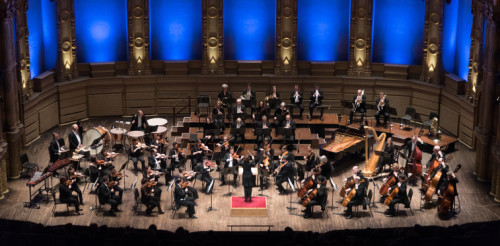 Canada Oesterle, Grieg, Copland, Stravinsky: Stewart Goodyear (piano), Victoria Symphony Orchestra, Tania Miller (conductor), Orpheum Theatre, Vancouver, 3.2.2016. (GN)
Canada Oesterle, Grieg, Copland, Stravinsky: Stewart Goodyear (piano), Victoria Symphony Orchestra, Tania Miller (conductor), Orpheum Theatre, Vancouver, 3.2.2016. (GN)

Michael Oesterle: Entr’actes
Grieg: Concerto in A minor for Piano and Orchestra, Op. 16
Copland: Appalachian Spring
Stravinsky: Firebird: Suite (1919)
Unlike the Baroque orchestras of the Pacific Northwest, which now flow seamlessly between Vancouver, Victoria, Seattle and Portland, it has been a long-standing tradition for the larger orchestras to stay on their own turf. It is indeed a rare event for the Victoria Symphony to appear in Vancouver. A 75th anniversary concert – under the auspices of the Vancouver Symphony and funded by the Canada Council – appeared to be just the catalyst needed, and I was taken by the warm-hearted and enthusiastic reception that the orchestra received, especially the standing ovation at the end. The earlier stops on the tour were Ottawa, Toronto and Quebec City.
The Victoria Symphony was founded in 1941 as an amateur orchestra and became a professional ensemble in the mid-1970s during the tenure of conductor Laszlo Gati. Paul Freeman took over as music director in 1979, to be followed by Peter McCoppin and Kees Bakels. In what was then a fairly daring idea, Tania Miller was appointed as music director in 2003, one of the noteworthy early appointments of a female in this role and a first in Canada, a position she continues to hold (see article). She was previously Associate Conductor of the Vancouver Symphony. The now-celebrated Yannick Nézet-Séguin was appointed as Principal Guest Conductor in the same year, eventually succeeded by Alain Trudel in 2009. The orchestra has recently released two CDs by Dutch composer Wim Zwaag (b. 1960).
With only 34 core musicians, expandable to 50, the Victoria Symphony is definitely a small orchestra. It would be idle to pretend that that it can achieve the body and weight of larger ensembles, yet it achieves a precise, clean and balanced sound, and given the enthusiasm of its timpanist, William Linwood, one which never lacks for power or drama at the climaxes. The strings might do with some extra luster but, under Maestra Miller and concertmaster Terence Tam, they seem eminently responsive and work hard to achieve detail and resilience. Though sometimes light on character, the winds and brass also do a fine job. Alana Despins is an exceptional principal horn and oboist Michael Byrne is capable of considerable poetry, among others.
The opening piece was a modern composition from Michael Oesterle (b.1968). He is a German-born composer, yet his Entr’actes sounded wonderfully French. A soft, melancholic Poulenc-like motive, played variously on harp, flute and xylophone, appears at the opening and recurs throughout the piece, only to be broken by great surges of orchestral momentum. These including spontaneous marching band and circus-like effects that would have made Milhaud and Satie smile. The composition moves well, defines effective contrasts and has lots of joie-de-vivre. All parts of the orchestra combined to deliver it in sterling style.
Pianist Stewart Goodyear has become a fixture in the Victoria Symphony’s regular season, and he appeared this time in the Grieg concerto. Goodyear is an excellent pianist who trained originally at Toronto’s Royal Conservatory but also has a graduate degree from Juilliard. He has become increasingly well known since his recording of the complete Beethoven Piano Sonatas was released by Marquis Classics in 2012.
This Grieg performance was on the straightforward side, finding good line and purpose in both the opening and closing movements, but rather light on atmosphere and poetic sensibility. Goodyear consistently showed poise, intelligence and a remarkably clean, firm tone, and he supplied all the virtuoso weight needed. His cadenzas were quite riveting. The orchestra always managed to find strong adrenalin at climaxes too, especially right at the very close. These were mainly sufficient to take the performance home, but one could not help but note an overall absence of lyrical flow and flexibility, especially in the Adagio, which often seemed laboured rather than freely expressive. Here Goodyear’s playing was more ‘square’ than flowing, and the orchestra seemed too heavy. Tania Miller’s conducting was always conscientious, but she sometimes had to make a noticeable effort to get string accents in the right place and to extract unanimity from other sections of the orchestra, which naturally cut against a feeling of spontaneous unfolding.
In the second half, Copland’s Appalachian Spring and Stravinsky’s Firebird Suite received estimable performances, though again the conductor’s needed care in execution had both an upside and a downside. In the Copland, I was very impressed by the precision in many difficult string passages, the control of dynamics and the unanimity and balance at climaxes. However, the careful deliberation seemed to slow the music down somewhat and remove its sparkle. This was a very exacting, but also a very slow, performance of the Copland. Solo wind and brass players really showed their mettle throughout the Firebird, adding to its charm, and the finale was built with tremendous radiance and power. There were places where the sensuality of the playing might have been greater, yet I did feel an increasing cohesiveness in the orchestra’s response as this work progressed. The performance fully deserved the long standing ovation it received.
This was an inspiring event, and I think everyone else who attended felt that too. Part of it was about comradery with our ‘little sister’ orchestra; another was about seeing just how well it could play and just how much orchestral power it could actually muster. Obviously, Tania Miller has made great strides in putting orchestral discipline in place; the next step perhaps is to slowly remove that control and let the players’ confidence in each other more fully carry the load.
Geoffrey Newman
Previously published in a slightly different form on http://www.vanclassicalmusic.com.
